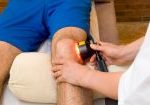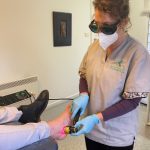
Low-level laser therapy (LLLT), also known as cold laser therapy or photobiomodulation therapy, is a medical treatment that uses low-intensity lasers or light-emitting diodes (LEDs) to stimulate healing and reduce pain and inflammation in various medical conditions, including those affecting the foot and ankle.
Here’s how low-level laser therapy is used for foot and ankle conditions:
- Principle: LLLT operates on the principle of photobiomodulation, which means that specific wavelengths of light are used to stimulate cellular processes. The low-level laser emits light at these specific wavelengths, which is absorbed by cells in the target tissue. This absorption can help stimulate various cellular processes and enhance tissue repair.
- Application: Your Cheltenham Podiatrist will apply the laser or LED directly to the affected area of the leg, foot or ankle. The light penetrates the skin and reaches the underlying tissues.
- Benefits for Foot and Ankle Conditions:
- Pain Relief: LLLT can help reduce pain, via slowing the neural pathway.
- Inflammation Reduction: The therapy has anti-inflammatory effects, which can be beneficial for conditions involving inflammation.
- Tissue Repair: LLLT stimulates the production of ATP (adenosine triphosphate) energy to cells. This can accelerate the repair and regeneration of damaged tissues.
- Improved Circulation: LLLT may increase blood flow to the treated area, aiding in the healing process.
- Treatment Sessions: The number of treatment sessions and the duration of each session can vary depending on the specific condition being treated. Typically, a course of several sessions is recommended for most conditions
- Safety: LLLT is considered a safe and non-invasive treatment option. It does not produce heat and cannot burn or cause tissue damage.
- Efficacy: it is effective for many foot and ankle conditions.

Low-level laser therapy (LLLT), also known as cold laser therapy or photo biomodulation therapy, works based on the principles of photo biomodulation.
Here’s how it works:
- Light Absorption: LLLT uses low-intensity lasers or light-emitting diodes (LEDs) that emit specific wavelengths of light. These wavelengths are typically in the red or near-infrared range. When the LLLT device is applied to the skin, the light penetrates the tissue and is absorbed by cells and cellular components.
- Cellular Effects: The absorbed light energy interacts with cellular components, particularly with a molecule called cytochrome c oxidase, a molecule known as a chromophore, which is a G protein couple receptor, that when activated, provides energy via the electron transport chain in mitochondria (the energy-producing organelles of cells). This interaction triggers a series of cellular responses, including:
- Increased ATP Production: Cytochrome c oxidase becomes more active, leading to an increase in the production of adenosine triphosphate (ATP). ATP is the primary energy currency of cells. With more ATP available, cells have the energy needed for various processes, including repair and regeneration.
- Reduction of Reactive Oxygen Species (ROS): LLLT can reduce the production of harmful reactive oxygen species, which are molecules that can cause cell damage and inflammation.
- Enhanced Nitric Oxide Release: LLLT may stimulate the release of nitric oxide, a molecule that plays a role in vasodilation (widening of blood vessels). This can improve blood flow to the treated area, delivering more oxygen and nutrients to the cells.
- Anti-Inflammatory Effects: LLLT can modulate the inflammatory response by reducing the release of pro-inflammatory molecules and promoting the release of anti-inflammatory factors.
- Cellular Proliferation and Tissue Repair: LLLT can stimulate the proliferation of certain cell types, such as fibroblasts, which are involved in tissue repair and collagen production. This can accelerate the healing process.
- Analgesic Effects: LLLT can also have analgesic (pain-relieving) effects by reducing nerve sensitivity and the release of pain-causing substances.
- Dosage and Specific Wavelengths: The effectiveness of LLLT depends on the specific wavelength of light used and the energy density (dosage) applied. Different wavelengths penetrate tissues to different depths, and the choice of wavelength depends on the target tissue and condition being treated. Often from 630nm to 905 nm.
- Safety: LLLT is considered a safe therapy when administered correctly. It does not produce heat, and there is a low risk of tissue damage or burns. However, proper protocols and safety guidelines must be followed to avoid adverse effects.
Low-level laser therapy (LLLT) has been used as a complementary or adjunctive treatment for various foot and leg conditions. While it’s not always the primary treatment, it can be effective in reducing pain, inflammation, and promoting tissue healing in the following conditions:
- Plantar Fasciitis: LLLT can help alleviate the pain and inflammation associated with plantar fasciitis, a common condition characterized by heel pain. The therapy can stimulate tissue repair in the plantar fascia.
- Achilles Tendonitis: LLLT may be used to reduce pain and inflammation in the Achilles tendon, a large tendon that connects the calf muscles to the heel bone. This can be helpful in cases of Achilles tendonitis.
- Ankle Sprains: For mild to moderate ankle sprains, LLLT can aid in reducing pain and swelling and promoting faster healing of ligaments and soft tissues around the ankle.
- Shin Splints: LLLT can be used to manage the pain and inflammation associated with shin splints, which often affect athletes and runners.
- Osteoarthritis: LLLT may provide relief from the pain and stiffness associated with osteoarthritis in the foot and ankle joints.
- Diabetic Foot Ulcers: LLLT has shown promise in promoting the healing of diabetic foot ulcers by improving circulation and accelerating tissue repair.
- Peripheral Neuropathy: In cases of peripheral neuropathy, which can cause pain, numbness, and tingling in the feet and legs, LLLT may help alleviate symptoms by improving nerve function.
- Tendon and Ligament Injuries: LLLT can be used to support the healing of various tendon and ligament injuries in the foot and leg, such as those in the toes or ankle.
- Oedema Reduction: LLLT may assist in reducing oedema (swelling) in the lower extremities, which can be beneficial in cases of traumatic injuries or conditions involving fluid retention.
- Wound Healing: LLLT has been used to accelerate wound healing, which can be crucial in cases of foot or leg wounds, particularly in diabetic patients.
- Nerve Damage/Entrapment: Normalises nerve function and thus reduces pain.
There are over 400 clinical trials that have been published, there is substantial clinical evidence published in peer reviewed medical journals that laser can stimulate repair of tissue, reduce inflammation and relieve pain in musculoskeletal repairs.
LLLT often used solely or as part of a comprehensive treatment plan that may include other interventions, such as physical therapy, orthotics, and lifestyle modifications. The specific parameters of the LLLT treatment, including wavelength, dosage, and duration, will vary depending on the condition and the individual patient. Cheltenham Podiatry has been using this therapy for over 8 years, and Jacqueline has trained with world leaders in this field, and and also partaken in a laser safety course. If you would like to asses if your condition is suitable for this treatment please call now to make an appointment with our lead podiatrist Jacqueline.
Book an appointment today
Latest News
Ankle Arthritis
Understanding Ankle Arthritis and Regenerative Treatment Options in Podiatry Ankle[…]




